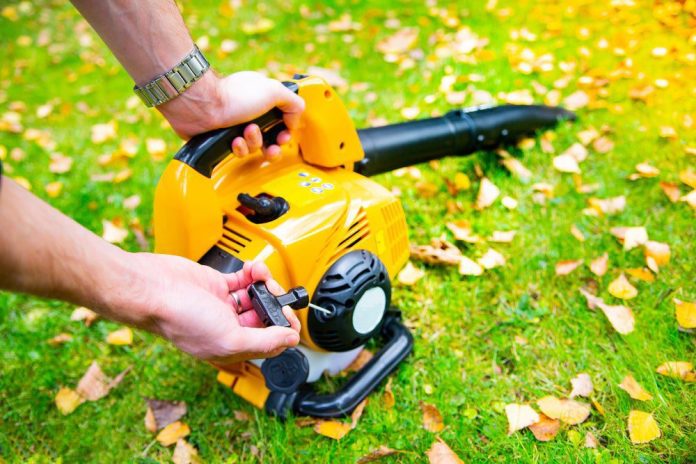Have you ever been frustrated with a leaf blower that refuses to start? We’ve all been there.
Whether it’s getting ready to give your yard a fresh clean or amid a fall leaf-collecting frenzy, a non-starting leaf blower can put a damper on your plans.
However, fear not! In this article, we’ll guide you through some simple troubleshooting steps to get your leaf blower up and running again so you can easily tackle those outdoor chores.
Say goodbye to the headaches and hello to a fully functional leaf blower once again!
Checking the Fuel
Checking the Fuel Tank
When troubleshooting a leaf blower that won’t start, checking the fuel tank is essential. Make sure the blower has enough fuel to operate. Look for any signs of contamination, such as dirt or debris in the tank. If the fuel appears old or contaminated, it is recommended to drain it and replace it with fresh fuel. Ensure the fuel cap is tightly secured to avoid any leaks during operation.
Inspecting the Fuel Line
After checking the fuel tank, inspecting the fuel line is crucial. Look for any signs of damage, such as cracks or leaks, along the fuel line. If there is damage, it may lead to fuel not reaching the engine properly and cause starting issues. Replace any damaged fuel lines to ensure a smooth fuel flow. Also, ensure the fuel line is correctly connected to the tank and the carburetor.
Examining the Fuel Filter
The fuel filter is another component affecting the leaf blower’s starting. A clogged or dirty fuel filter can restrict fuel flow to the engine, resulting in starting problems. Locate the fuel filter and inspect it for any debris or blockages. If the filter appears dirty, clean it thoroughly or replace it if necessary. Regularly cleaning or replacing the fuel filter is essential for maintaining the blower’s optimal performance.
Inspecting the Spark Plug
Removing and Inspecting the Spark Plug
A faulty spark plug is a common cause of starting issues in leaf blowers. To inspect the spark plug, remove it from the engine using a spark plug wrench.
Once removed, carefully examine the spark plug for any signs of wear, damage, or fouling. If the spark plug has excessive wear, replacing it with a new one is best. Ensure that the spark plug gap is within the manufacturer’s recommended specifications.
Cleaning or Replacing the Spark Plug
If the spark plug appears dirty or fouled, it can be cleaned using a wire brush or a spark plug cleaner. Remove any carbon deposits or dirt from the spark plug electrodes and the insulator.
However, replacing the spark plug with a new one is recommended if it is severely fouled or damaged. A clean and properly functioning spark plug is vital for a smooth ignition and efficient operation of the leaf blower.
Examining the Air Filter
Locating and Accessing the Air Filter
The air filter plays a significant role in maintaining the leaf blower’s performance by preventing dust, debris, and other particles from entering the engine. Start by locating the air filter housing, usually near the carburetor. Depending on the model, it may have a cover that can be removed by loosening screws or clips to access the air filter.
Inspecting and Cleaning the Air Filter
Inspect the air filter for any dirt, dust, or debris accumulation. If the air filter appears clogged or excessively dirty, it can impede the airflow and cause starting problems. Clean the air filter by gently tapping it against a clean surface to remove loose debris. If it remains dirty, washing it with mild detergent and warm water is recommended. Allow the filter to dry completely before reinstalling it.
Replacing the Air Filter
Replacing the air filter with a new one is essential if it is damaged, excessively dirty, or beyond cleaning. Refer to the manufacturer’s instructions to select the correct replacement filter. Install the new air filter securely, ensuring it is correctly seated in the housing. Regularly checking and replacing the air filter will enhance the blower’s overall performance and prolong its lifespan.
Ensuring Proper Choke and Throttle Settings
Checking the Choke Setting
The choke setting on a leaf blower controls the ratio of air to fuel during the starting process. Ensure that the choke is in the correct position for starting. Typically, the choke should be closed or partially closed when starting a cold engine. However, for a warm engine, the choke should be fully open. Verify that the choke mechanism is functioning correctly and adjust it as necessary.
Verifying the Throttle Position
The throttle setting also plays a crucial role in the starting process of a leaf blower. Ensure that the throttle trigger is in the proper position. Some blowers require the throttle to be entirely squeezed before starting, while others have a specific starting position indicated on the throttle trigger. Verify that the throttle is set to the correct position to provide the necessary fuel-air mixture for starting the engine.
Cleaning or Replacing Carburetor
Removing and Cleaning the Carburetor
If the leaf blower continues to have starting issues, cleaning or replacing the carburetor may be necessary. Start by locating the carburetor, usually attached to or near the engine. Carefully remove the carburetor, following the manufacturer’s instructions and using the appropriate tools. Once removed, clean the carburetor thoroughly using carburetor cleaner, ensuring all passages, jets, and ports are free from debris.
Replacing the Carburetor
If cleaning the carburetor does not resolve the starting problem, it may be necessary to replace it. Consult the blower’s manual or contact the manufacturer for the correct replacement carburetor. Install the new carburetor following the manufacturer’s instructions, ensuring all connections are secure. A properly functioning carburetor is vital for the fuel mixture and overall performance of the leaf blower.

Checking the Ignition Coil
Testing the Ignition Coil with a Spark Tester
A faulty ignition coil can prevent the leaf blower from starting. To test the ignition coil, use a spark tester. Remove the spark plug and connect the spark tester to the spark plug wire. Pull the starter rope to simulate the engine starting. If the spark tester does not show a spark, it indicates a faulty ignition coil that needs to be replaced. A working ignition coil generates the spark needed to start the engine.
Replacing the Ignition Coil
If the ignition coil fails the spark tester, it must be replaced. Refer to the blower’s manual or contact the manufacturer for the correct replacement ignition coil. Disconnect the old ignition coil and install the new one, ensuring all connections are secure. An efficient ignition coil is essential for consistent ignition and reliable leaf blower starting.
Inspecting the Exhaust System
Checking for Clogs or Blockages
A clogged or blocked exhaust system can cause starting issues in a leaf blower. Inspect the exhaust outlet and muffler for any signs of obstruction, such as dirt, debris, or carbon buildup. Use a small brush or compressed air to remove blockages and ensure proper exhaust flow. It is essential to perform this inspection regularly to prevent any restrictions in the exhaust system.
Clearing the Exhaust System
If the exhaust system appears heavily clogged or blocked, it may be necessary to remove and clean it thoroughly. Disconnect the exhaust from the engine, following the manufacturer’s instructions. Clean the exhaust system using a brush to remove stubborn dirt or debris. Ensure all components are correctly reconnected and tightened after cleancorrectlylear exhaust system promotes better engine performance and easier starting.
Inspecting the Starter Assembly
Checking the Starter Rope and Recoil Spring
Faulty components in the starter assembly can contribute to starting issues. Inspect the starter rope for signs of fraying or damage. If the rope appears worn or damaged, it is recommended to replace it to ensure reliable starting. Additionally, check the recoil spring for any signs of damage or weakness. A broken or weak recoil spring can prevent the starter assembly from functioning correctly, leading to starting problems.
Replacing the Starter Assembly
If the starter rope or recoil spring is deemed faulty, replace the entire starter assembly. It may be necessary. Refer to the blower’s manual or contact the manufacturer for the correct replacement starter assembly. Carefully remove the old assembly and install the new one, ensuring all connections are secure. A properly functioning starter assembly is vital for the easy and consistent leaf blower starting.
Checking the Kill Switch
Verifying the Kill Switch Position
The kill switch is a safety feature that allows users to quickly stop the leaf blower in an emergency. However, a mispositioned kill switch can prevent the blower from starting. Ensure the kill switch is in the correct position, usually marked as “ON” or “RUN.” Verify that the switch is not stuck in the “OFF” or “STOP” position, as this will prevent the engine from starting.
Cleaning the Kill Switch
If the kill switch appears dirty or contaminated, gently clean it with a soft brush or compressed air. Ensure all dirt or debris is removed from the switch and surrounding area. A clean and properly positioned kill switch ensures a smooth starting process and helps maintain safety while operating the leaf blower.
Testing the On/Off Switch
Checking for Power Output
The on/off switch controls the power supply to the leaf blower’s ignition system. Faulty contacts or wiring in the switch can prevent the blower from starting. Use a multimeter to check if the on/off switch provides power output when in the “ON” position. If no power output is detected, it indicates a faulty switch that needs to be replaced for proper starting operation.
Replacing the On/Off Switch
If the on/off switch fails the power output test, it is necessary to replace it. Consult the blower’s manual or contact the manufacturer for the correct replacement switch. Carefully disconnect the old switch and install the new one, ensuring all connections are secure. A functioning on/off switch ensures a reliable power supply to the ignition system, promoting consistent starting of the leaf blower.
By following these troubleshooting steps and thoroughly inspecting the fuel, spark plug, air filter, choke and throttle settings, carburetor, ignition c, oil, exhaust system, starter assembly, kill switch, and on/off switch, you will significantly increase the chances of resolving starting issues with your leaf blower.
Regular maintenance and prompt addressing of any problems will ensure successful starting and contribute to your leaf blower’s longevity and optimal performance. Always refer to the manufacturer’s instructions and safety guidelines when working on machinery. Happy leaf-blowing!



































